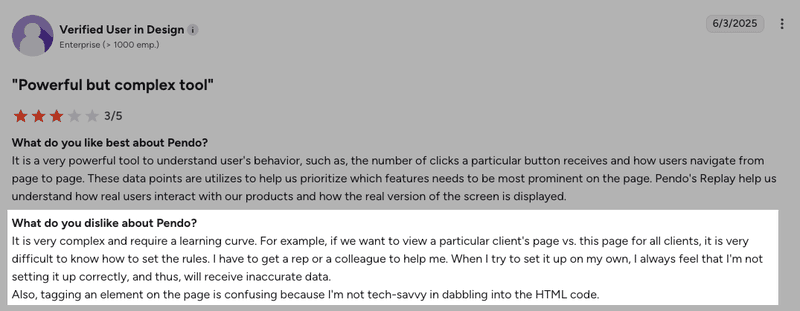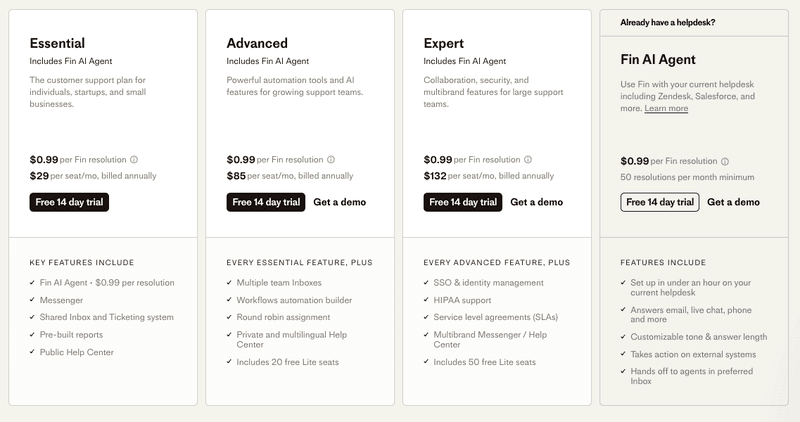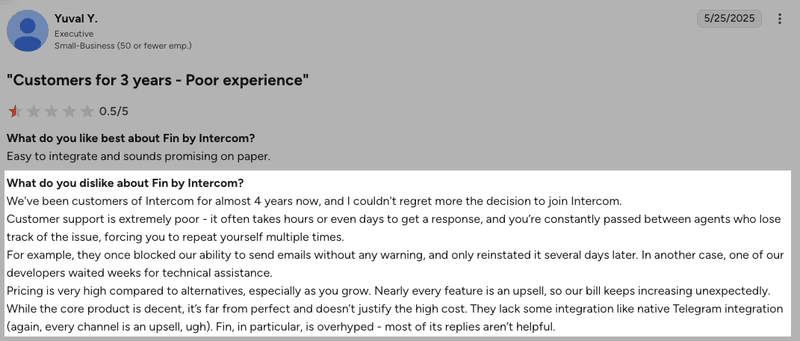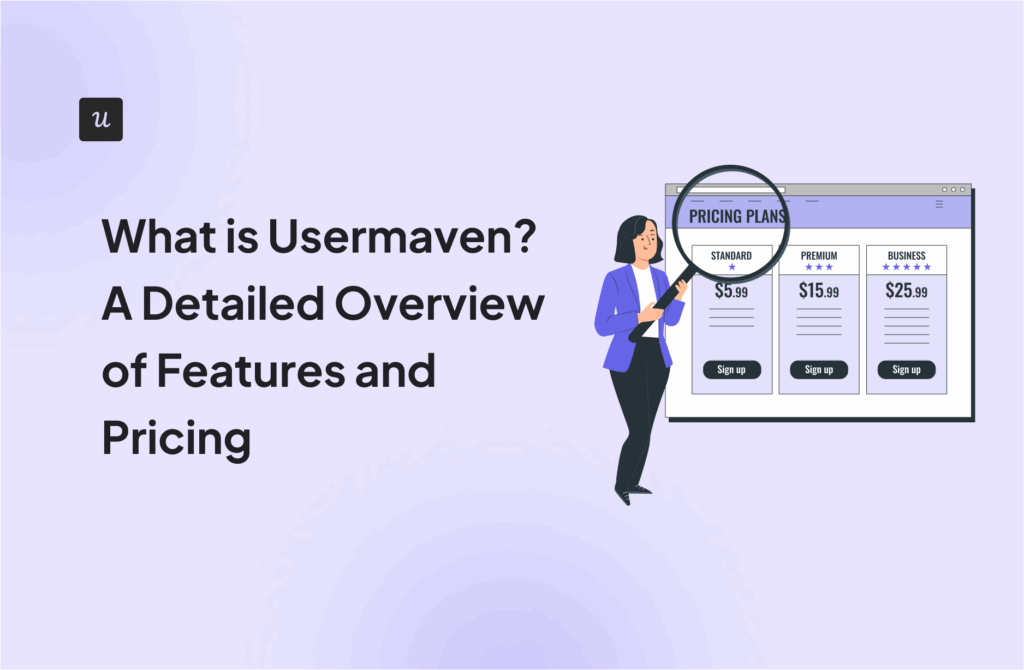
If you’re comparing Pendo vs Intercom, you must be looking at their product engagement and user onboarding features.
However, both platforms have a wide offering of other functionalities. Pendo provides advanced product analytics, while Intercom is a customer support market leader.
If you’re wondering which tool will get you more value for money, stick around. I’ll compare the tools’ key features, use cases, and pricing models, plus propose an alternative so that you can make an educated decision.
Pendo vs Intercom: What is your primary goal right now?
How important is a completely no-code solution for your team?
What does your budget and pricing preference look like?
You’re looking for a better alternative to Pendo vs Intercom.
Based on your need for a value-driven, no-code solution focused on user engagement, a dedicated product growth platform is the perfect fit. See why Userpilot is the top choice for teams looking to move beyond the limitations of Pendo and Intercom.
Try Userpilot Now
See Why 1,000+ Teams Choose Userpilot

Intercom vs Pendo: Side-by-side comparison
At a high level, this is how Intercom and Pendo compare to each other:
| Feature | Intercom | Pendo |
|---|---|---|
| G2 rating | 4.5 | 4.4 |
| Pricing | Starts with (if billed annually): 💰 $0.99 per Fin resolution 💰 $29 per seat/mo 💰 +$99 for Proactive Support Plus add‑on |
💰 Undisclosed; MAU‑based |
| In‑app user engagement | ⚠️ Part of Proactive Support Plus add‑on (must be purchased on top of a regular plan) | ✅ Available on all plans |
| Email and mobile | ✅ Email + mobile (available via Proactive Support Plus) | ✅ Mobile + emails |
| Resource center | ✅ Public and private. Supports multilingual on the Advanced+ plan | ✅ Includes onboarding modules, announcements, and help resources |
| Surveys | ⚠️ Surveys available only in Proactive Support Plus add-on | ⚠️ Surveys available only as part of guides (not a separate module) |
| Segmentation | ⚠️ Developer help needed for initial segmentation setup | ✅ Attribute‑ and event‑based targeting |
| Product analytics | ❌ Support metrics only | ✅ Includes usage analytics, reports, dashboards, heatmaps, and session replays |
| Helpdesk features | ✅ Chat, inbox/tickets, knowledge base | ❌ No help desk (focus on in‑app guides/analytics) |
Pendo: Software experience platform for SaaS product teams
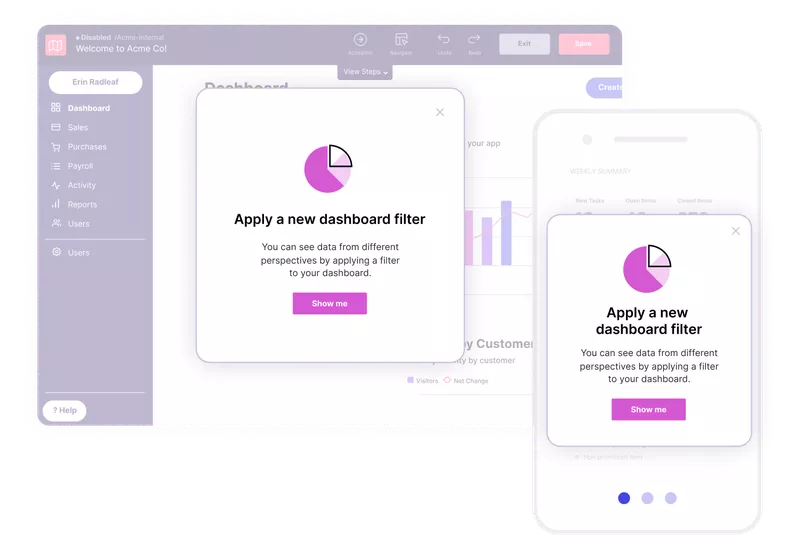
Pendo markets itself as “the first software experience platform” (SXM), positioning itself as a separate category. In reality, it’s an all-in-one product platform that combines in‑app guidance, product analytics, roadmapping, and customer feedback.
For product teams in complex B2B SaaS, Pendo can deploy contextual guides (across web, email, and mobile), host NPS and other surveys, track events and pages, and show actionable data dashboards in one place. It also offers a promise of a completely no-code experience after the initial setup. However, as I’ll explain, the value you get will depend on the size of your budget and technical level.
What can you use Pendo for?
- Onboard new users and introduce features: With Pendo’s engagement features, you can create interactive walkthroughs with UI patterns such as tooltips, lightboxes (modals), banners, and polls. It also supports multi‑step walkthroughs and checklists via the resource center’s onboarding module. Everything is customizable and created in a visual designer.
- Analyze user behavior: Pendo analytics can track pages, capture in-app events automatically (though you’d need dev help to instrument them or set up server-side events), and analyze product usage via dashboards/reports. Plus, it supports session replays and feature heatmaps to help you figure out the why behind the numbers.
- Create synchronized product communication: It can coordinate guides via web apps, mobile, and email. Pendo can also show onboarding checklists and announcements via the resource center.
- Collect user feedback: It’s possible to trigger micro-surveys (including NPS) with Pendo Guides, as well as add feedback forms to the resource center. NPS surveys are separate, and you can add them to in-app banners or emails.
- Personalize customer experiences: Pendo guides can be targeted based on the user’s attributes and in-app interactions. This, coupled with auto-capture, makes it easier to personalize the product experience in one platform.
How much does Pendo cost?
Pendo’s pricing model is quite convoluted. All prices are gated behind feature-dependent quote requests.
Many more features sit behind add‑ons or higher tiers. These include Guides Pro, AI localization, Journey Orchestration, unbranded/advanced NPS, plus the separate Pendo Feedback product with seat‑based pricing. Even on the Ultimate plan, you need add-ons to access embedded and cross-app guides.
Here’s how Pendo’s pricing plans are structured:
- Free (up to 500 MAUs): Includes core analytics, in‑app guides, roadmaps, and Pendo‑branded NPS. After you exhaust the MAU limit, you can no longer create guides and segments, plus your usage data gets sampled to 500 random users. This makes Pendo Free more of a glorified trial than a commercially usable plan.
- Base: Adds 1 integration with analytics and guides.
- Core: Everything in Base and session replays.
- Pulse: Everything in Core, NPS, and product discovery.
- Ultimate: Everything in Pulse, Guides Pro, journey orchestration, and data sync.
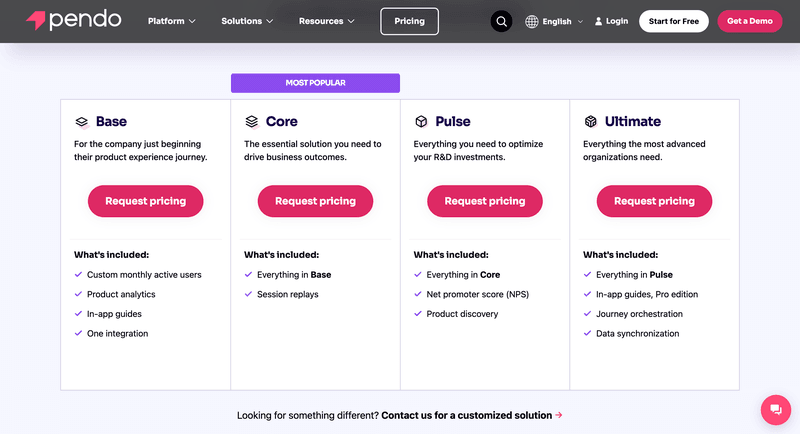
To know how much you’re likely to pay, Vendr’s data shows that the median ACV for Pendo is around $48k/yr (ranging between $15k–$146k+ depending on MAU and add‑ons).
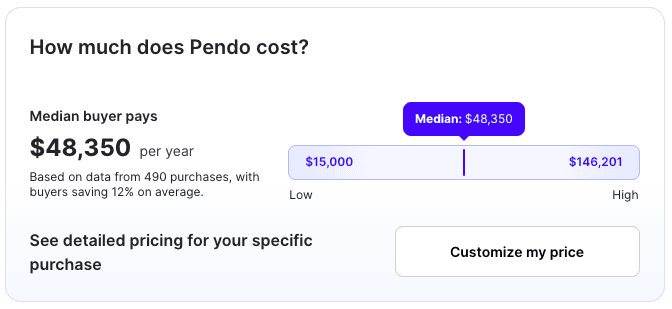
In short, despite having a solid product, Pendo’s unpredictable pricing offers poor value for money. Expect your renewal costs to increase aggressively as you get more MAUs, seats, and extra needs.
Pro tip: If Pendo’s pricing became a concern and you’re looking to switch from Pendo, we offer a deal where we pay 50% off your current Pendo contract price or renewal rate and give you free access to Userpilot until expiration.
What are the advantages of Pendo?
✅ All‑in‑one product platform: Engagement, analytics, and feedback live in one place. This means you can get a global view of the user journey and trigger the right messages based on product data.
✅ Easy user‑journey orchestration: The visual, no‑code workflows let you coordinate omnichannel customer experience (website, mobile, email). Announcements, in-app walkthroughs, and onboarding emails can work cohesively as part of one communication strategy.
✅ Comprehensive analytics tools: The whole analytics suite includes retroactive data capture, broad event coverage, custom dashboards, and behavioral reports, giving a complete view of user engagement across multiple products.
What are the disadvantages of Pendo?
⚠️ Steep learning curve: Implementation is complex (metadata, tagging, segments), and the UI can overwhelm new users. For example, Shelterluv moved to Userpilot after struggling to make Pendo usable day‑to‑day, mentioning that they just “don’t know how to use it”:
“It is very complex and requires a learning curve… When I try to set it up on my own, I always feel that I’m not setting it up correctly… Tagging an element on the page is confusing.” — Matthew Brown, Senior Customer Solutions Manager at Shelterluv
⚠️ Basic feature limitations: Some basics are missing or gated. For instance, there are no spotlights, push notifications for mobile aren’t live yet, and the Guides Pro feature is behind an add-on. Plus, AI features like auto‑translation are also locked behind an add-on while falling behind industry standards (e.g., localization still doesn’t support RTL languages).
⚠️ Not fully no‑code: You’ll still need developers to set up both client- and server-side events.
⚠️ Limitations on lower plans: Essential PLG features are locked behind an add-on or higher-tier plan. So unless you’re on one of their top-tier plans (Pulse or Ultimate), you’re stuck with incomplete functionalities for core features like NPS analytics and advanced segmentation.
⚠️ Non‑transparent pricing: MAU‑based prices combined with undisclosed add‑ons result in bills that climb on each renewal. Users regularly mention 5–10% uplifts at renewal (sometimes up to 20%), which makes budgeting more difficult than it should be.
Intercom: Customer service suite with user engagement features
Intercom is first and foremost a customer service platform: live chat, help desk, tickets, and a knowledge hub for your support team.
It also has Outbound and the Product Tours add-on on top of their support suite. It can trigger in‑app nudges, banners, tooltips, and even micro‑videos to implement onboarding. So, this add-on is useful if you already use Intercom and only need a lightweight solution for in-app messaging.
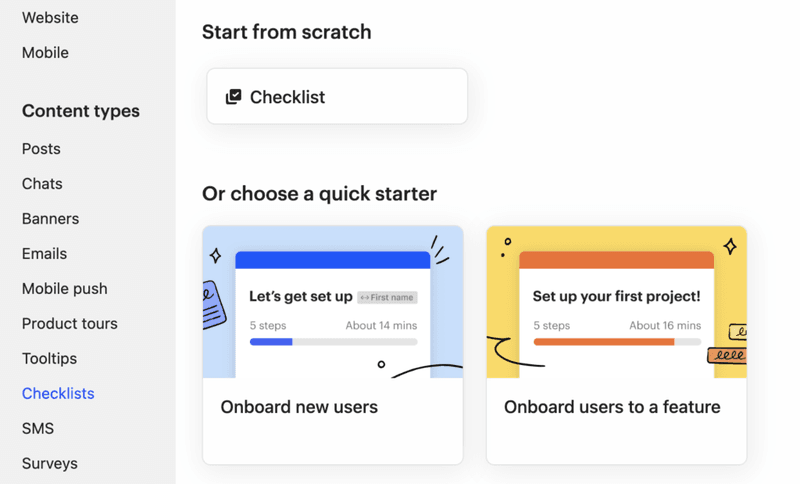
What can you use Intercom for?
- Set up a customer support engine: Intercom’s main features are live chat, inbox, tickets, and a searchable help center. This makes it a solid option if you also need a help center platform.
- Onboard, educate, and notify users: The Outbound messaging covers in‑app chats, banners, and tooltips on core plans. Meanwhile, the Proactive Support add-on includes tooltips, emails, checklists, banners, SMS, push notifications, and product tours. Also, the in‑app help center allows users to access self-service support inside your product.
- Set up omnichannel customer communication: Intercom gives you the ability to talk with customers across on-demand chats, email, web apps, and mobile. However, this feature is mostly for CS teams who need to keep in touch with users on different channels.
- Collect customer feedback: Intercom surveys live in the Proactive Support add‑on. They include segmentation, branching, and logic, and work well for quick CSAT/NPS pulse feedback.
- Analyze customer support data: Intercom’s analytics include support metrics (response times, resolution rates, customer interactions, workload). However, you’ll need to integrate other tools for full product analytics.
How much does Intercom cost?
Intercom pricing combines per‑seat plans with usage‑based fees for its customer service tools and add-ons, making it quite complex for starters.
Here are the base plans for their support platform:
- Essential ($29/seat/mo.): Includes Messenger, shared inbox, pre-built reports, and a public help center.
- Advanced ($85/seat/mo.): Everything in Essential plus multiple team inboxes, a workflow automation builder, and a multilingual Help Center.
- Expert ($132/seat/mo.): Everything in Advanced plus SSO & identity management, HIPAA support, and SLAs.
All of these plans get access to Fin (their AI agent), which costs $0.99 for each ticket resolution regardless of your plan. Then you have the add-ons, which include:
- Proactive Support Plus ($99/mo.): Includes checklists, product tours, surveys, and series with 500 messages/mo included. Over that, you have to pay between $0.07 and $0.0175, depending on the total number of messages.
- Copilot ($29 per agent/mo.): An AI assistant in the inbox with unlimited usage.
According to Vendr data, the median ACV sits around $30,456/yr (range $5,955–$168,818 depending on seats, message volume, Fin resolutions, and add‑ons). This means Intercom’s pricing is unpredictable and easy to ramp up based on seats, Fin resolutions, and message caps.
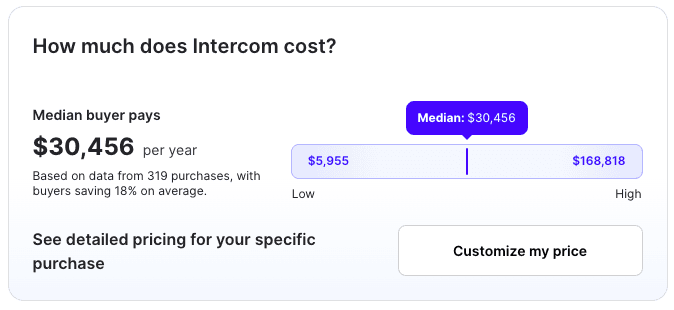
What are the advantages of Intercom?
✅ Comprehensive customer support tool: Intercom is a market‑leading help desk platform with omnichannel communication. If your CS team is in need of a new help desk, Intercom gives them everything they need in one place.
✅ Strong integration ecosystem: With 300+ apps in the Intercom App Store, you can fill feature gaps with tools for billing, CRM, or analytics.
✅ No‑code product tour builder: All content types, including outbound messages, tours, banners, onboarding tooltips, carousels, and checklists, can be built visually. This makes it useful for implementing onboarding in Intercom without pulling engineers off your core roadmap.
What are the disadvantages of Intercom?
⚠️ Not tailored for product teams: Intercom is CS‑first (the fact that Product Tours are just an add-on demonstrates this.) Product managers will discover limitations when trying to build segments/triggers from product data because that data doesn’t live natively in Intercom. For example, Talana chose Userpilot over Intercom specifically because Intercom couldn’t handle their dynamic attributes and unique URLs:
“In Talana, we have a lot of pages, URLs, and they all change depending on the customer and the company. And this was something that Intercom was not able to offer.” — María Ignacia Videla, Head of Communication and Content at Talana
⚠️ Message quotas limit growth initiatives: The Proactive Support add-on includes only 500 messages/month. You’ll quickly hit the ceiling and pay unpredictable prices after that.
⚠️ No product data analytics: You’ll need to connect external analytics tools to collect event data, or import data if you need to segment users for personalization. That adds extra setup compared to an all‑in‑one product platform.
⚠️ Not fully no‑code: Builders are visual, but event tracking for behavior‑based targeting requires developer work. This includes instrumenting custom events via the JS/REST SDK, passing user/company attributes, or tracking server‑side activity for targeting.
⚠️ Unpredictable costs: Pricing depends on seats, Fin resolutions, add-ons, and messages sent, which makes it unpredictable. Some users report their billing going up with no prior notification.
Userpilot: A cost-effective product platform as an alternative to Pendo and Intercom
Userpilot is a product growth platform that brings user engagement, product analytics, and customer feedback together, combining reliability, speed, and good value-for-money.
As a Userpilot user, I can do all the product-related tasks without writing code (including onboarding, in-app upsells, product analytics, and surveys), and have access to a richer library of UI patterns compared to both Pendo and Intercom. On top of that, our pricing is the most cost-effective, predictable, and much less add-on-dependent.
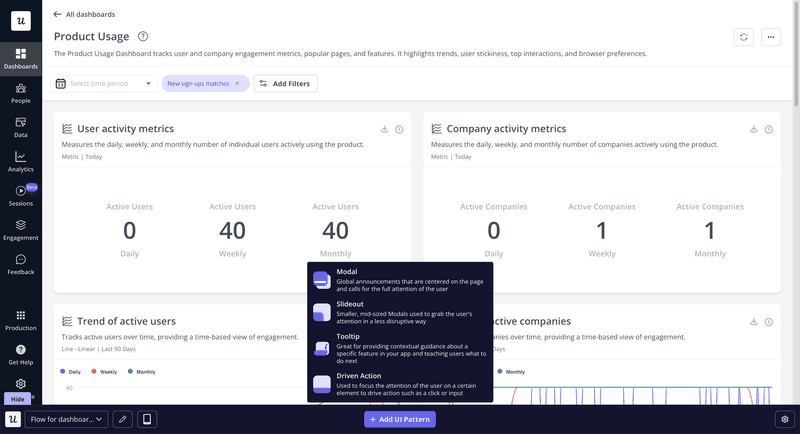
What can you use Userpilot for? Key features
- Onboard new users and introduce features: With Userpilot, I can build interactive walkthroughs with modals, tooltips, or onboarding checklists without touching code. I can also customize an in-app resource center where users can get self-service support.
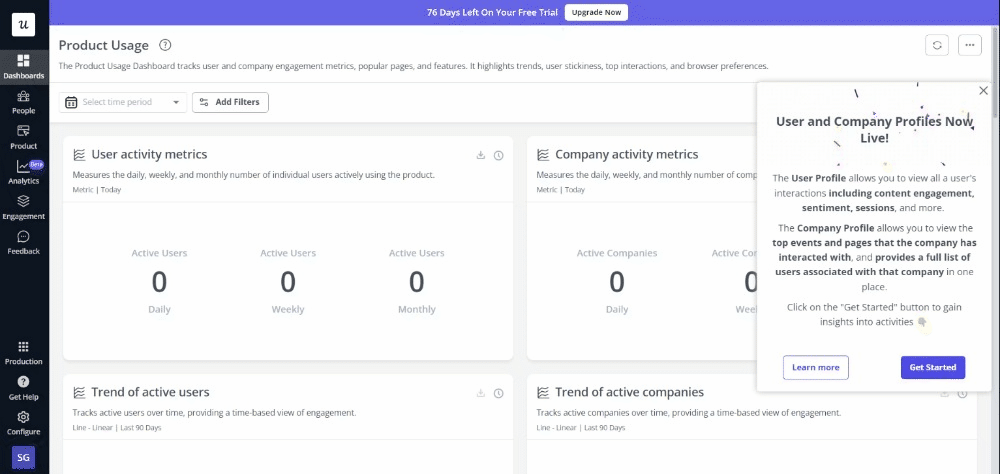
- Track and analyze product data: Userpilot’s autocapture collects all interactions with our products and in-app guidance elements. To start tracking, all I need to do is tag events and pages with a visual labeler (no dev team involved). I can also create custom dashboards and reports (i.e., trends, funnels, paths, and retention analysis) to analyze user engagement across channels and make data-driven decisions.
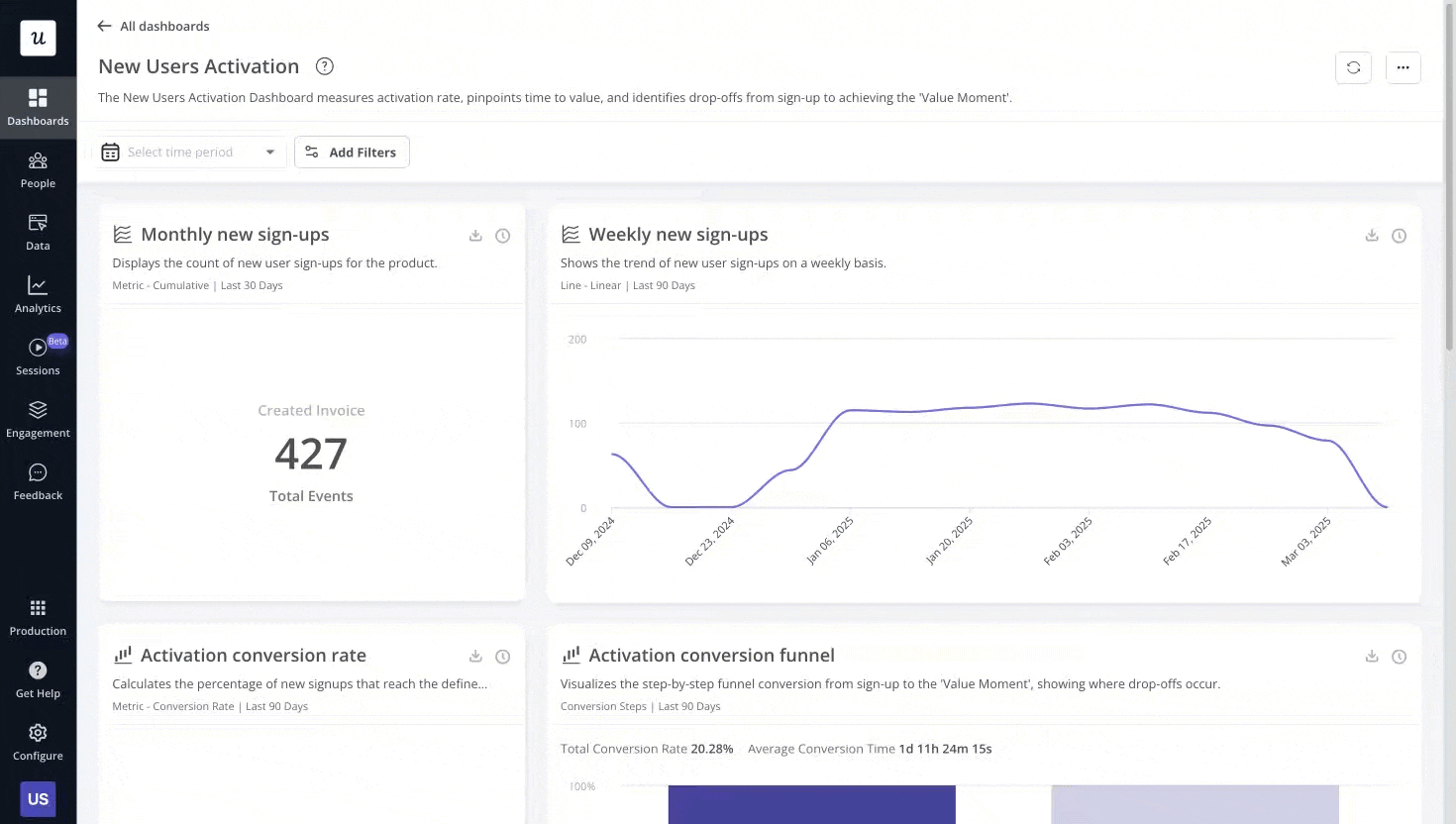
- Watch session replays: With session replays, I can watch exactly how users interact with our product, prove hypotheses, and find opportunities to improve usability. It’s also possible to leave comments, skip the idle parts, and share bug clips with engineers.
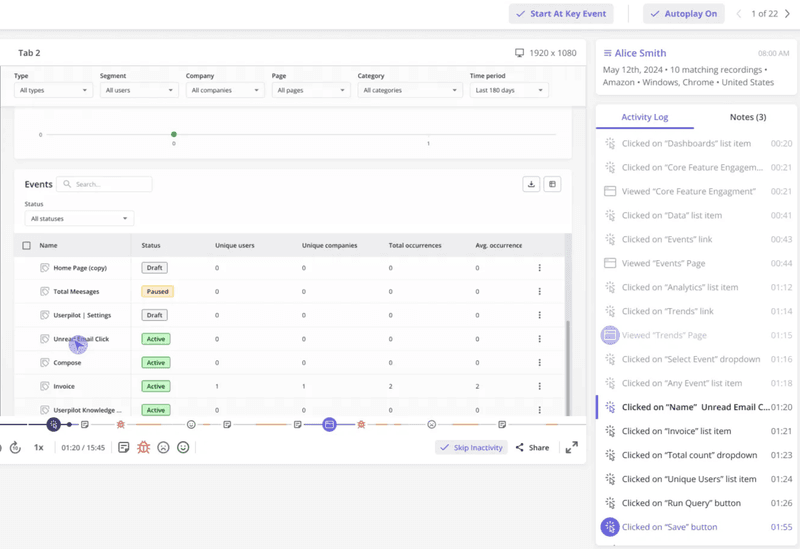
- Collect user feedback: Userpilot’s surveys are hosted as a separate module, so you can run them independently of your in-app guides. However, they can also be combined with flows if needed. Event-based targeting lets me easily trigger contextual transactional surveys for customer satisfaction when users are engaging with core features.
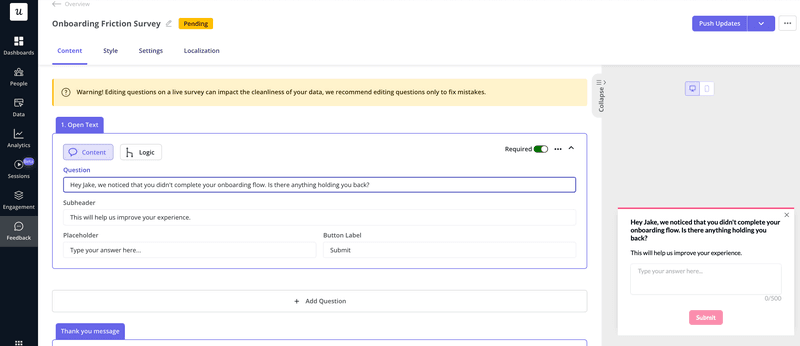
- Personalize and automate experiences: I have access to advanced segmentation, which lets me group users based on attributes, in-app behaviors, and survey answers. This way, I can personalize in-app messages, emails, or surveys to enhance the product experience.

- Set up omnichannel communication: Since Userpilot supports in‑app, mobile, and email channels for messaging, I can implement an omnichannel lifecycle strategy that guides users throughout their whole journey.
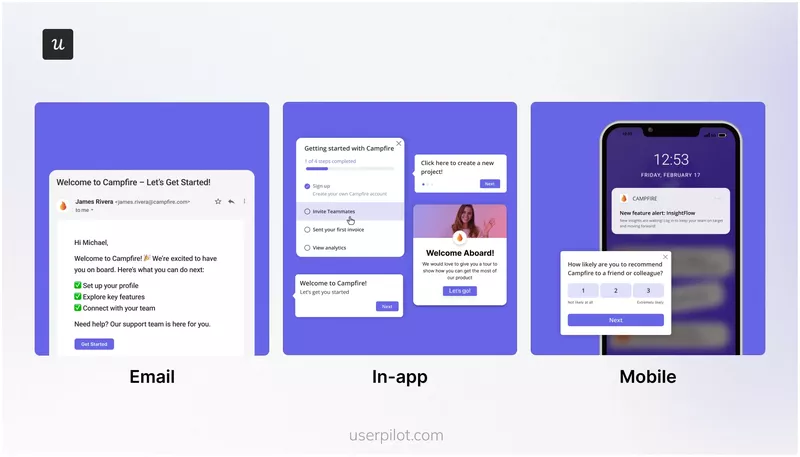
Why should you choose Userpilot over Pendo and Intercom?
✅ Easy to use and set up: Despite sharing many features with Pendo, Userpilot’s UI is more user-friendly, which allows you to use the features you’re paying for. For instance, Cuvama left Pendo because they weren’t able to use their plan to the fullest:
“High price was one of the decision criteria to move from Pendo because we were paying lots, and we were not using it.” — Leyre Iniguez, Customer Experience Lead at Cuvama
✅ More advanced UI elements: Compared to Pendo, Userpilot offers more UI patterns like spotlights and push notifications (essential for mobile). Plus, there’s unlimited access to in-app guidance on all plans (except resource centers and emails, which are only available after Growth), no pay-per-use or sneaky add-ons.
✅ Fully no‑code data capture and actionable insights: Intercom doesn’t provide product usage analytics. And while Pendo does have strong analytics tools, using these events typically needs extra dev help (e.g., only “Click Events” tied to feature tags show up in certain reports). With Userpilot, you capture events instantly via autocapture and turn them into usable analytics through a visual interface. Plus, Userpilot reports are centralized, while Pendo’s data is split across modules like Data Explorer, Guides, Listen, and Dashboards (with extra configuration for widgets).
✅ Real‑time data: Userpilot’s analytics update in real time. Meanwhile, Pendo’s analytics refresh hourly, so there will always be an inherent lag in your reports.
✅ Transparent pricing: Unlike Pendo or Intercom, Userpilot’s pricing model is simple, predictable, and accessible:
- Starter (from $299/mo): For up to 2,000 MAU. Includes in‑app user engagement, user segmentation, event tracking, usage analytics, and NPS.
- Growth (custom): Everything in Starter plus custom MAUs, advanced product analytics, event autocapture, resource center, advanced in‑app surveys, email engagement, unlimited session replays (add-on), and mobile engagement (add-on).
- Enterprise (custom): Everything in Growth plus premium integrations, bulk data export/import, Data Warehouse Sync, custom permissions, SAML SSO, activity logs, security audit, compliance, and custom contract/SLA.

Userpilot is less expensive according to Vendr, with a median ACV of $11,000/yr and a typical range of $3,200–$33,067. Customers who switched to us from Pendo or Intercom often mentioned pricing as one of the key arguments for the change, citing a much better value for money with improved usability.
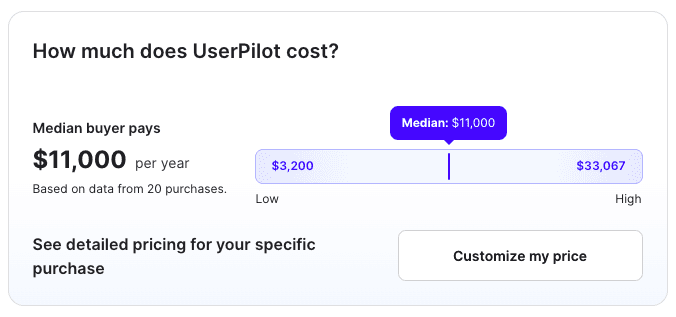
Pendo, Intercom, or Userpilot: What’s the best choice?
Intercom is good for businesses that need a best‑in‑class help desk with some onboarding tools sprinkled on top. If you’re looking for an all‑in‑one product platform, both Pendo and Userpilot are a better idea.
However, Pendo’s installation is complex, its learning curve is steep, and it’s unnecessarily expensive. Userpilot gives you the same surface area for PLG, but fully no‑code, with real‑time data, richer UI patterns, and transparent pricing.
So if you want to check how Userpilot can help you implement onboarding and support product growth, book a demo to start focusing on growing your product.
DISCLAIMER: Userpilot strives to provide accurate information to help businesses determine the best solution for their particular needs. Due to the dynamic nature of the industry, the features offered by Userpilot and others often change over time. The statements made in this article are accurate to the best of Userpilot’s knowledge as of its publication/most recent update on August 24, 2025.



